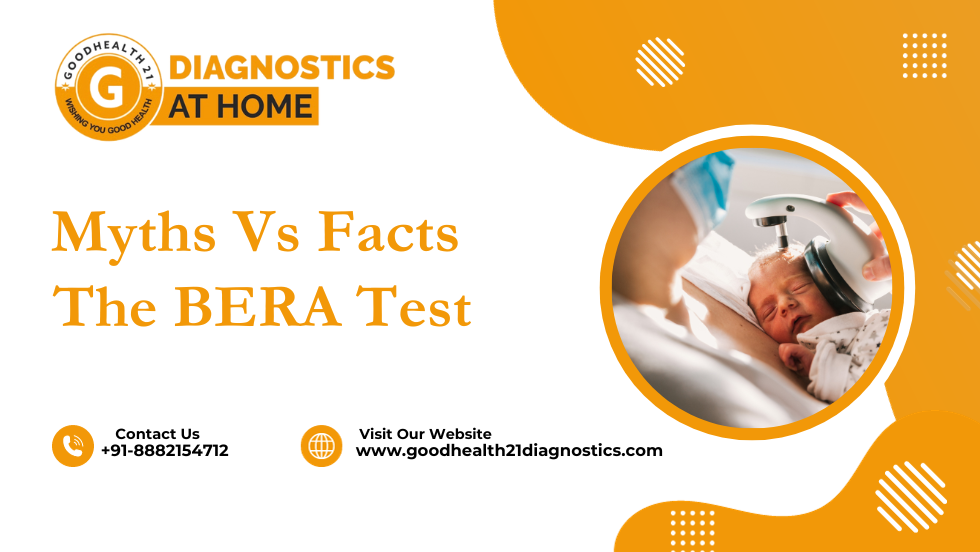Medical diagnostics and assessments play a critical role in understanding and addressing various health concerns. One such diagnostic tool is the Brainstem Auditory Evoked Response (BAER or BERA) test, which is used to evaluate auditory functions and identify hearing-related issues, especially in newborns and young children. Despite its importance, there are several myths and misconceptions surrounding BERA tests that can create confusion and anxiety among parents and caregivers. In this article, we aim to debunk some of the common myths and clarify the facts about BERA tests.
Myth 1: BERA Tests Are Painful and Distressing
Fact: BERA tests are non-invasive and painless. The procedure involves placing electrodes on the scalp and behind the ears to monitor the auditory nerve’s response to sound stimuli. There are no needles, incisions, or uncomfortable sensations involved. While infants may fuss during the test due to the need to remain still, it does not cause physical pain.
Myth 2: BERA Tests Expose Children to Harmful Radiation
Fact: BERA tests do not use any form of radiation. They rely on harmless auditory stimuli, such as clicks or tones, and measure the brain’s electrical responses to these sounds. The test poses no risk of radiation exposure to the child or the healthcare provider.
Myth 3: BERA Tests Are Only for Children with Obvious Hearing Problems
Fact: BERA tests are used to assess auditory function, and they are not limited to children with apparent hearing impairments. They can detect various auditory issues, including subtle abnormalities in the auditory pathway. BERA tests are particularly valuable in identifying hearing problems in newborns who may not exhibit obvious signs of hearing loss.
Myth 4: BERA Tests Are Unreliable and Yield Inaccurate Results
Fact: When performed by trained professionals and in appropriate clinical settings, BERA tests are highly reliable and provide accurate information about auditory function. Like any medical test, the quality of the results depends on the expertise of the healthcare provider and the test’s conditions.
Myth 5: BERA Tests Are Time-Consuming and Tedious
Fact: BERA tests are relatively quick, typically taking about 15-30 minutes to complete. While young children may require some time to settle and remain still, the test itself is not time-consuming. The brevity of the test is essential, especially for infants and toddlers who may have limited attention spans.
Myth 6: BERA Tests Are Invasive and Require Sedation
Fact: BERA tests are entirely non-invasive and do not necessitate sedation. They involve attaching electrodes to the scalp and behind the ears to record the brain’s responses to auditory stimuli. There is no need for anesthesia or sedation during the procedure.
Myth 7: BERA Tests Are Only for Detecting Hearing Loss
Fact: While BERA tests are often associated with hearing loss diagnosis, they can also reveal information about the auditory pathway and neural processing of sound. They can be valuable in identifying various auditory disorders beyond hearing loss, such as auditory neuropathy.
Myth 8: BERA Tests Can Be Performed Anytime
Fact: BERA tests are typically conducted when a child is calm, alert, and not experiencing ear infections or other illnesses that could affect the test results. It is crucial to schedule the test during a time when the child is cooperative and at their best condition.
Myth 9: BERA Tests Are Unnecessary for Children Who Pass New-born Hearing Screenings
Fact: Newborn hearing screenings are effective in identifying significant hearing impairments, but they may not detect subtle auditory issues or auditory neuropathy. BERA tests are valuable for a more in-depth assessment, especially when there are concerns about auditory development or when a child exhibits signs of hearing problems later on.
Myth 10: BERA Tests Are Only for Audiologists
Fact: BERA tests are typically performed by audiologists, but they are also interpreted by pediatricians, otolaryngologists, and other healthcare providers. The results of the test guide medical professionals in diagnosing and developing appropriate treatment plans for auditory issues.
Myth 11: BERA Tests Are Unimportant Because Hearing Issues Will Resolve on Their Own
Fact: Some hearing issues in children may resolve naturally, but not all will. Early detection and intervention are critical for ensuring that any hearing problems are addressed promptly. BERA tests provide vital information for diagnosing and managing these issues effectively.
Myth 12: BERA Tests Can Be Conducted at Home
Fact: BERA tests require specialized equipment and the expertise of trained healthcare professionals. They cannot be performed at home and should only be conducted in a clinical or hospital setting by qualified audiologists or medical professionals.
In conclusion, understanding the facts about BERA tests is essential for dispelling common myths and misconceptions that may cause unwarranted fear or confusion among parents and caregivers. BERA tests are valuable tools for assessing auditory function, especially in children, and their non-invasive, painless nature makes them an important diagnostic option for addressing hearing-related concerns. When administered by trained professionals in suitable clinical settings, BERA tests can provide accurate insights into auditory health, guiding appropriate interventions and care.

